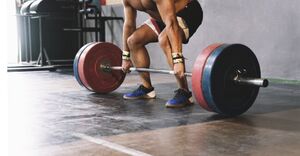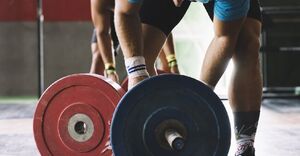
Kettlebell Weight Guide: Discover the Perfect Weight for Your Workout
Are you looking to take your fitness routine to the next level with kettlebells, but unsure where to start?
This guide covers everything you need to know about choosing the right weight kettlebell for your training.
Learn about the various types of kettlebells available, the benefits of using the correct weight, common mistakes to avoid, and tips on how to progress to heavier kettlebells.
Get ready to elevate your workouts and see results with the perfect kettlebell weight.
What Is a Kettlebell?
A kettlebell is a versatile piece of fitness equipment that resembles a cannonball with a handle attached. It is commonly used for strength and conditioning workouts, offering a wide range of exercises to target various muscle groups and provide a full-body workout.
The unique shape of a kettlebell makes it ideal for dynamic movements that engage multiple muscle groups simultaneously, enhancing both strength and cardiovascular fitness. Its design allows for a seamless transition between different exercises, promoting fluidity and efficiency in workout routines. From swings and cleans to Turkish get-ups and snatches, kettlebells can be utilized for power, endurance, and mobility training. They are especially effective for building grip strength and enhancing core stability, making them a favorite among fitness enthusiasts and athletes alike.
Why Use Kettlebells for Training?
Kettlebells are favored for training due to their ability to engage multiple muscle groups simultaneously, promote functional movements, and improve overall conditioning. They offer a dynamic workout experience that challenges both strength and cardiovascular endurance.
Beginners can benefit greatly from incorporating kettlebells into their routine, as the various weighted options make it accessible for all fitness levels. Learning proper technique and form is crucial when using kettlebells to prevent injuries and ensure maximum effectiveness.
By incorporating exercises like swings, cleans, and presses, individuals can target muscles in the arms, legs, back, and core. To maximize results, progressive overload is key, gradually increasing weight and intensity.
It’s important to listen to your body and allow for adequate rest between sessions to prevent overtraining and injury.
What Are the Different Types of Kettlebells?
There are various types of kettlebells available on the market, each differing in material, handle design, size, and grip options. These variations allow users to select a kettlebell that best suits their preferences and training needs.
Cast iron kettlebells are a popular choice for their classic and durable design, making them ideal for intense strength training. On the other hand, vinyl-coated kettlebells offer a more comfortable grip and protect floors from scratches, making them well-suited for home workouts. Competition kettlebells adhere to specific weight and dimensions for consistency in competitions, providing a uniform experience for athletes. The handle design of kettlebells also varies, with some featuring smooth handles for quick transitions between exercises, while others have textured grips for enhanced stability during swings and lifts.
Cast Iron Kettlebells
Cast iron kettlebells are a traditional and popular choice among fitness enthusiasts for their durability, classic design, and versatility in strength training routines. These kettlebells are known for their solid build and ability to withstand heavy use.
Available in a wide range of weights, cast iron kettlebells cater to individuals of all fitness levels, from beginners to advanced lifters. Their sturdy construction provides a stable grip during exercises, ensuring proper form and effective muscle engagement.
In addition to strength training, these kettlebells are also excellent for enhancing cardiovascular fitness and overall endurance. Made from high-quality cast iron, they boast longevity and resilience, allowing for years of intensive training without losing their shape or performance.
To maintain their quality, it is essential to regularly clean and store them in a dry environment to prevent rust and corrosion.
Vinyl-Coated Kettlebells
Vinyl-coated kettlebells offer a comfortable and non-slip grip due to their protective coating, making them an excellent choice for users concerned about handle comfort and grip security during workouts. These kettlebells come in a variety of weights to suit different fitness levels.
The ergonomic handle design of vinyl-coated kettlebells allows for a secure and comfortable grip, reducing the risk of hand slippage or fatigue during exercises. This feature is particularly beneficial for individuals with specific handle preferences, ensuring a stable hold throughout their workout routines.
The vinyl coating not only enhances the grip but also provides a protective layer that helps prevent damage to floors or other equipment in case of accidental drops. When selecting the right weight, it’s essential to start with a lighter kettlebell and gradually increase as strength and proficiency improve.
Regularly checking the vinyl coating for any signs of wear and tear, and wiping it down after each use, can help maintain the kettlebells’ longevity and performance.
Competition Kettlebells
Competition kettlebells are standardized in weight and dimensions to ensure consistency for competitive events and training programs. These kettlebells are designed with competition-grade materials, handles, and grips to meet the requirements of professional kettlebell athletes.
The uniform weight of competition kettlebells, typically ranging from 8 kg to 48 kg, allows athletes to progress in a controlled and structured manner. The handle dimensions are carefully crafted to provide a comfortable yet secure grip for various kettlebell movements, including swings, snatches, and cleans. The grip standards set for competition kettlebells ensure a consistent feel across different brands, promoting fair play and accurate performance assessment. These features make competition kettlebells ideal for advanced athletes looking to hone their skills and for individuals preparing for kettlebell sport competitions.
How to Choose the Right Weight for Your Kettlebell?
Selecting the appropriate weight for your kettlebell is crucial to ensure a safe and effective workout. Factors such as your fitness level, training goals, and familiarity with kettlebell exercises play a key role in determining the right weight for your training program.
Consider starting with a lighter weight if you are new to kettlebell training to focus on proper form and technique. As you progress, you can gradually increase the weight to challenge yourself and continuously improve.
Pay attention to the handle size and grip of the kettlebell as it should feel comfortable and secure in your hand during exercises. Be mindful of your specific training objectives, whether it is building strength, improving endurance, or enhancing overall fitness, as this will also influence the weight selection.
Remember, it’s better to start with a weight that feels slightly lighter and gradually work your way up rather than risking injury by choosing one that is too heavy.”
Consider Your Fitness Level
When choosing a kettlebell weight, it’s essential to assess your current fitness level and strength capabilities to avoid overexertion or injury. Starting with a weight that allows you to perform exercises with proper form and technique is crucial for a safe training experience.
Engaging in a thorough warm-up routine before kettlebell workouts can help prepare your muscles for the upcoming challenges. Dynamic stretches, such as arm circles, leg swings, and hip rotations, can improve blood circulation and enhance flexibility. Incorporating bodyweight exercises like squats, lunges, and planks can activate core muscles and prime your body for kettlebell movements. As you progress, gradually increasing the weight load and reps will help build endurance and strength effectively. Remember, consistency and patience are key in achieving long-term fitness goals.
Determine Your Training Goals
Your training goals and objectives should influence the choice of kettlebell weight to ensure that your routines are challenging yet achievable. Whether you aim to build strength, improve endurance, or enhance overall fitness, selecting the right weight is essential for effective workouts.
For those looking to focus on building strength, opting for heavier kettlebells that challenge muscle groups and encourage progression is key. Exercises like goblet squats, Turkish get-ups, and single-arm swings with a weight that allows for 6-8 repetitions per set can help achieve strength gains.
On the other hand, individuals aiming to improve endurance may benefit from using lighter kettlebells for high-repetition exercises like kettlebell swings, snatches, and windmills that promote cardiovascular stamina and muscular endurance.
Consult with a Trainer
Seeking guidance from a qualified trainer or fitness professional can help you determine the ideal kettlebell weight based on your individual needs, abilities, and training objectives. A trainer can assess your form, technique, and progress to recommend the most suitable weight for optimal results.
In addition to weight selection, a skilled trainer can provide crucial insights into proper kettlebell techniques and forms, ensuring you execute exercises safely and effectively. Their personalized guidance can help prevent injuries and enhance your overall performance.
When looking for a trainer experienced in kettlebell training, consider seeking recommendations from fellow gym-goers, researching online reviews, or reaching out to local fitness communities for referrals. An experienced trainer can tailor workouts to fit your specific goals and fitness level, creating a customized plan that maximizes your potential.
What Are the Benefits of Using the Right Weight Kettlebell?
Using the correct weight kettlebell in your workouts can lead to improved strength, enhanced conditioning, and targeted muscle development. The right kettlebell size and handle design ensure comfort and efficiency during exercises, contributing to a more effective and rewarding training experience.
Selecting the appropriate kettlebell weight plays a crucial role in maximizing your workout potential. By choosing a weight that challenges your muscles without compromising form, you can promote significant strength gains over time. The balanced weight distribution in a well-sized kettlebell allows for smooth transitions between exercises, aiding in overall conditioning. The right handle size not only ensures a secure grip but also enables proper alignment of the wrist and arm, optimizing muscle engagement and reducing the risk of injury.
What Are the Common Mistakes When Choosing a Kettlebell Weight?
Several common mistakes are made when selecting a kettlebell weight, including improper grip assessment, neglecting to align the weight with the training program, and failing to consider progressive overload through repetitions and sets. These errors can hinder training progress and increase the risk of injury.
One of the key issues individuals face is underestimating the importance of grip comfort. It’s essential to ensure that the kettlebell handle is appropriate for your hand size and allows for a secure grip to prevent discomfort and potential injuries.
Another prevalent mistake is not tailoring the kettlebell weight to match the specific training program. Matching the weight to your strength level and the intended exercises is crucial for effective and safe workouts.
Overlooking the principle of progressive overload by not gradually increasing repetitions and sets can limit the results you achieve. To avoid these pitfalls, focus on proper grip evaluation, weight selection based on your program, and consistent progression in your training routine.
Choosing Too Light of a Weight
Opting for a kettlebell that is too light for your strength level can limit the effectiveness of your workouts, particularly for men and women aiming to build muscle and enhance fitness at home. Using an appropriate weight range ensures that your exercises provide an ample challenge for progress.
If the weight is too light, your muscles may not be adequately stimulated to grow and strengthen. This lack of resistance can hinder muscle development and slow down your fitness improvements over time.
To optimize your training results, it is recommended for men to start with kettlebells ranging from 16kg to 24kg, while women may find weights between 8kg to 16kg more suitable. Choosing the right weight range will help you push your limits, increase muscle mass, and enhance overall performance.
Choosing Too Heavy of a Weight
Selecting a kettlebell weight that is excessively heavy can lead to compromised form, increased injury risks, and hindered progression in your fitness journey. Maintaining proper form, preventing injuries, and ensuring a suitable weight range are vital considerations for effective and safe training.
To mitigate the risks associated with lifting a kettlebell that is too heavy, it is crucial to focus on gradual progression. Starting with a weight that allows you to perform exercises with proper technique is key. Gradually increasing the weight as your strength and proficiency improve will help prevent strain and injury. Paying close attention to your body’s signals, such as discomfort or strain, is essential. Listening to your body and making adjustments in weight selection accordingly can significantly reduce the chances of injury and optimize your performance outcomes.
Not Considering Proper Form
Neglecting proper form when choosing a kettlebell weight can impact muscle engagement, conditioning benefits, and overall training efficacy. Focusing on technique, muscle group activation, and gradual progression within an appropriate weight range are essential for maximizing the benefits of kettlebell exercises.
Engaging multiple muscle groups simultaneously during kettlebell workouts not only enhances strength but also improves coordination and stability. By starting with a weight that allows for proper form and control, individuals can efficiently activate target muscles while reducing the risk of injury.
As one’s proficiency grows, increasing the weight incrementally and mastering advanced techniques can lead to significant gains in muscle endurance, power, and functional fitness. Consistent practice, attention to form, and a tailored progression plan are key components in achieving long-term success with kettlebell training.
How to Progress to Heavier Kettlebells?
Advancing to heavier kettlebells requires a systematic approach that includes adequate warm-up routines, safety precautions, and an understanding of the benefits for muscle building and endurance. Progressing to heavier weights should be done gradually to minimize injury risks and maximize training gains.
Start by increasing the weight by no more than 2-4 kg at a time to allow your muscles to adapt progressively. Focus on maintaining proper form throughout each exercise, as this is crucial for injury prevention and optimal muscle engagement. Ensure that you are incorporating rest days into your routine to allow for muscle recovery and growth. By gradually increasing the weight load in your kettlebell workouts, you can effectively challenge your muscles, leading to greater strength gains and improved endurance over time.
Increase Reps and Sets
To progress to heavier kettlebells, gradually increase the number of repetitions and sets in your training program. Incremental changes in volume and intensity help build strength, enhance muscular endurance, and prepare your body for lifting heavier weights effectively.
This progressive approach, known as progressive overload, plays a crucial role in stimulating muscle growth and improving overall fitness levels. By gradually adding more repetitions and sets over time, your muscles are challenged in a progressive manner, which forces them to adapt and grow stronger.
This method not only promotes strength gains but also helps in enhancing your endurance levels, allowing you to sustain physical exertion for longer durations. The gradual nature of this approach ensures that your body can gradually adapt to the higher resistance levels of the heavier kettlebells, reducing the risk of injury and enhancing your overall performance.
Increase Time Under Tension
Elevating the time under tension during kettlebell exercises can enhance muscle activation, conditioning effects, and grip strength development. By focusing on controlled movements, muscle engagement, and efficient handle usage, you can optimize the benefits of kettlebell training with heavier weights.
This strategic approach not only challenges your muscles more effectively but also helps in building endurance and stability. Gradually increasing the duration of each repetition and intentionally slowing down the eccentric and concentric phases can significantly impact muscle recruitment. Varying your exercise tempo, such as performing slow eccentric movements followed by explosive concentric actions, can lead to greater strength gains. To further boost your grip strength, consider using thicker-handled kettlebells or incorporating specific grip-strengthening exercises into your routine.
Try Different Kettlebell Exercises
Exploring a variety of kettlebell exercises with proper technique, form variations, and targeted muscle group engagement can facilitate progression to heavier weights. Incorporating diverse movements and training modalities challenges your body and prepares it for increased resistance levels effectively.
- By mastering exercises like kettlebell swings, Turkish get-ups, and renegade rows, you can develop a solid foundation for handling heavier kettlebells.
- Focusing on refining your form and technique ensures that you are effectively engaging specific muscle groups, leading to enhanced strength and stability.
- Variety in your workouts not only keeps things interesting but also prevents plateaus in your progress. Remember, the key to progress is continuously challenging yourself with new movements and variations to keep your muscles adapting and growing.




No Comments